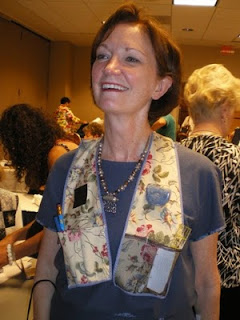Couture Vest Challenge 2010
Couture is based on custom fit and a style that flatters. The questions we asked ourselves were: Does my pattern have some shape and does it have construction details that allow me fit opportunities? Does the style draw attention to my face or emphasize my best features?
We did a muslin to perfect the fit and test the style. Silhouette, length, ease, proportion were all assessed. Was the fabric the best match for the pattern? Did the construction techniques eliminate bulk and were hand stitches emphasized over machine stitching? Thoughts were also given to types of facings and closures, such as snaps, buttons, or ties. Choice of interfacing, such as woven and sewn in types, and the type of lining, whether it's silk or other fiber, print or solid all affected the overall design of the garment.
Discussing what worked and what didn't work for each of our designs and fabrics helped make better choices for future garment construction.
Here are examples from the vest challenge:
 Here is what Jenny has to say about her vest challenge:
Here is what Jenny has to say about her vest challenge:The vest challenge was a great creative exercise. When our group first decided upon the challenge, I thought it meant sewing a vest by a particular date. “No problem,” I thought. Then during our initial conversation about how we were going to challenge ourselves I got it -- time to apply some constraints so this project would stretch my skills. I decided to use a piece of linen that had been aging in my stash for 20+ years (waiting for just the right project to appear), fitted my first princess vest pattern, added a covered placket to the front, and applied an embellishment with frayed edges.
What was the hardest aspect of the challenge? Those raw edges! Couture techniques generally emphasize beautiful seam finishes, so calling attention to the raw edges of the vest as a focal point was a real stretch.
There’s still a step or two to complete: seams to be catchstitched to the underlining, a bias facing for the armholes, and tacking down the placket so it stays where it should. Thanks to everyone who gave me encouragement and advice at the meeting on the final details. I had fun and learned a lot!
 This is what Martha says about her vest:
This is what Martha says about her vest: Using Nancy Erickson's blazer pattern, fitted by Pam Howard, I constructed this vest, mostly out of silk dupioni remnants. I followed Mary Ray's 3 articles in Threads magazines concerning quilted garments. The exterior pieces were assembled by cutting flannel batting generously for each of the pieces in this and then attaching the silk remnants in a sew-and-flip manner. Then I basted the silver silk to the other side of the flannel for the lining. After machine quilting each piece, I re-cut each garment piece to more precise measurements and sewed the pieces together in a typical manner. I tried out various seam finishes and the result is *almost* reversible, although I plan to add buttons and won't try to make that part reversible.


Here's what Nancy has to say about the vest she made for her daughter:
"First of all I would like to say that it was a good learning experience for me, thanks to Martina who guided me in this "couture" adventure, I was able to make the vest with all handmade details. The vest pattern originally is Vogue, the collar and part of the pockets are "chenille" (my very first time doing this technique) the other part of the pockets are made with the vest material with horizontal and vertical stitches, the buttons were made by my daughter from old pennies; she also made the bracelet from scraps of vest material and chenille."




